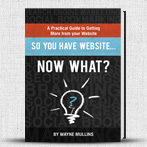It Starts & Ends With Marketing…
Well, where should we start? Let’s begin with the definition of marketing.
Marketing: Your ability to attract and keep a customer.
With that definition in mind, let me ask you, “How important is marketing to your business?” I’m sure you’d agree that it’s vital to your long-term business success. I mean, if you’re not attracting and then keeping customers, WHAT ARE YOU DOING?
Since the 1930’s marketing and advertising have slowly blended together in the minds of most business owners. Due in part to the mass commercialization of television and radio advertising, business owners started taking the “easy way out” by delegating their responsibility as the chief marketing officer of their company to the television and radio station sales reps.
After all, it’s much easier just to write someone a check and let them “handle your marketing” for you. Then, if the advertisement doesn’t bring in more customers, the business owner would have someone else to blame.
As a business owner myself, I’ll admit it’s much easier just to run a few ads here and there, and then hope for the best. But honestly, that’s just laziness on my part.
Most business owners, me included, are guilty of participating in “Ostrich Advertising.” Ostrich Advertising is when you’d rather just run an ad in the newspaper, yellow pages, radio, or television and then stick your head in the sand instead of measuring and tracking the results of your advertising.
There is a better way! But it requires building.
Specifically, by taking the time to build your marketing system you’ll be able to shift your marketing from an expense to an investment. See, a properly designed marketing system will enable you to manage and measure the return on every single dollar you spend on marketing and advertising.
There’s no such thing as a “perfect” marketing system, but all marketing systems should contain certain fundamental elements. Here are some of the elements your marketing system must contain, if it’s going to be worth the paper it’s printed on.
Marketing Vision
—this is where you define the goals of your marketing system and how it will integrate with your existing business systems. You can summarize your entire marketing system in a sentence or two.
Ideal Customer(s)
—why waste time marketing to people who have no need, interest, or desire for your product or service? Think for a minute about your best customer(s).What makes them so great? What if we could find more people exactly like them? How would that change the way you market your business?
It’s also crucial that you spend time understanding the lifetime value of each of your customers. Return on your marketing dollars can’t be calculated unless you know the lifetime value of each customer.
Here’s John Jantsch’s Formula for finding your “Ideal Customer”: Physical description + What they want + Their problem + How they buy + Best way to communicate with them = Ideal Customer. It doesn’t get much clearer than that.
Remarkable Difference/Position
—what makes your product or service different from your competitors? (Many define this as a Unique Selling Proposition, or USP.) A great question that may help is, “Why should my customer buy from me instead of my competitor?”
One way to understand positioning is to look at the auto industry. Have you ever noticed how the different auto companies position themselves? BMW—the Ultimate Driving Machine, Lexus—the Pursuit of Perfection. Looking at these two positioning statements can help you better understand positioning and how it can influence your business.
Core Messages
—your core messages are the main messages that you communicate to prospects and customers. Think of your core messages as the theme your business will take. These messages help prospects and customers understand your remarkable difference and position.
Most businesses give little—or no—thought to the messages they communicate to prospects and customers, which is why they have no flow and congruency within their marketing and advertising.
A great example of a Core Message is Domino’s – “Delivered in thirty minutes or it’s free.”
Lead Generation System
—where are your prospects? How can you find them? Better yet, how can you get them to beg you for the privilege of doing business with you? Sound like a pipe dream? Well, it isn’t “if” you have a plan and materials in place that help cause this to happen.
Here’s the Formula to use: Ideal Customer Identification + Suspect Identification + Filtering Mechanisms = Ideal Prospects
Lead Conversion System
–okay great, your prospect is on the phone, now what? How do you convert the prospect into a happy, paying customer? The “Lead Conversion” portion of your plan details exactly how you can convert more prospects into customers.
There are several areas that will be involved in this portion of your plan. Each area has the goal of leading the prospect a step closer to becoming a customer. Here are a few ideas of what may be involved:
“Prospect Follow-up Sequence / Sales Scripting / Cross Sales / Up Sales / Post Sale Surveying”
Referral System
—why spend all your time and effort trying to find prospects and “ideal” customers when you can have your existing clients do it for you? Simply by having a referral system, you’ll be way ahead of all your competitors. Over 98% of businesses in America don’t have a referral system in place.
Wouldn’t you rather reward current customers for sending you new business, instead of giving your money to newspapers, radio stations, or magazines?
Service Experience
—it’s important that your prospects’ and customers’ interactions with your business match the image your marketing portrays. This won’t happen by accident. You need a detailed system that outlines how each interaction with your company will occur.
Your goal should be to have a remarkable interaction with prospects and customers each and every time.
What’s a remarkable interaction? It’s simply an interaction that is so amazing prospects and customers can’t help but remark about it to friends and colleagues.
Marketing Calendar/Budget
—I’m sure you’d agree that it would be a good idea to know how much money you’re spending on marketing and advertising. How do you know what type of return on investment you’re receiving, if you don’t know how much you’re spending?
This portion of your marketing system not only details your budget, but it also outlines the sequences in which your marketing will occur. By carefully planning your marketing, you will be able to maximize the impact of all your efforts.
Measurement System
—how do you know if your car is about to run out of gas? Simple, you look at the built-in measuring tool called a gas gauge. You must develop similar measuring tools for your marketing. You do want to know if your marketing is working, right? It’s crucial that you take the time to create tools and procedures to help you monitor and evaluate the results.
Now What?
I’ve provided you with a step-by-step outline you can use to create your own marketing system. But if you’re anything like me, you don’t have the time to pull yourself away from the day-to-day business operations and focus on developing your marketing system. This creates somewhat of a problem, doesn’t it?
You know how important a marketing system is to the long-term success of your business. This isn’t something to put off another day–you simply can’t afford to.
“If you keep doing what you’ve been doing, you’ll keep getting what you’ve been getting.”
Three possible solutions:
1. Take time away from your schedule and create your detailed marketing plan. This is the best option, if you’re willing and able to make the commitment and get it done.
2. Find someone to help you create your marketing plan. Hiring someone to help you create your marketing system will allow you to stay focused on your business and reap the benefits.
Our work with clients helps them develop marketing systems that get results. However, due to time constraints, we accept clients on a very limited basis.
3. Do nothing. If you’re happy with the results you’ve been getting, then I recommend you just keep doing what you’ve been doing. No need to rock the boat. However, I’d be willing to bet you’re not willing to just continue coasting; you’re ready to take your business to the next level. So go ahead and see which marketing system you are ready to invest in from the options below.
Small Budget? Learn how the DIY Marketing System can revolutionize your business.
No Emergency Brake! Discover how the Deluxe Marketing System can transform your business into a profit-generating machine.
Please put on your Safety Glasses…Things might get a little dangerous with the Ultimate Marketing System. Let us skillfully guide your business through the marketing maze to a very successful outcome.
Have more questions? Contact us!
Categories
“If you are looking for design or development services, Ugly Mug Marketing is a great solution. Wayne and his team are honest, fair, and reasonably priced. Best of all, they deliver the work on time.”
NEIL PATEL



